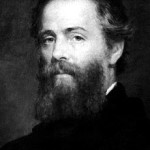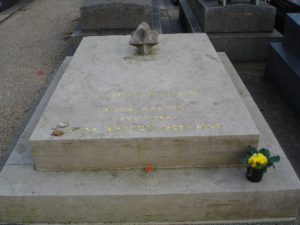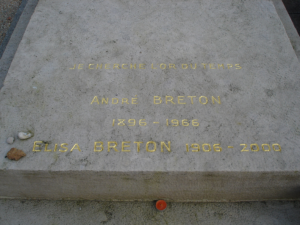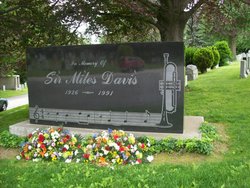 On this day in 1891 author Herman Melville died at his home in New York City at age 72 from cardiac dilation. Born in New York City on 1 August 1819. Best known for the novel Moby-Dick. His first three books gained much contemporary attention (the first, Typee, became a bestseller), but after a fast-blooming literary success in the late 1840s, his popularity declined precipitously in the mid-1850s and never recovered during his lifetime. It was not until the “Melville Revival” in the early 20th century that his work won recognition, especially Moby-Dick, which was hailed as one of the literary masterpieces of both American and world literature. In 1919, the unfinished manuscript for his novella Billy Budd was discovered by his first biographer, Raymond M. Weaver, who published a version in 1924. He was the first writer to have his works collected and published by the Library of America. Melville married Elizabeth Shaw (1847 – 1891 his death).
On this day in 1891 author Herman Melville died at his home in New York City at age 72 from cardiac dilation. Born in New York City on 1 August 1819. Best known for the novel Moby-Dick. His first three books gained much contemporary attention (the first, Typee, became a bestseller), but after a fast-blooming literary success in the late 1840s, his popularity declined precipitously in the mid-1850s and never recovered during his lifetime. It was not until the “Melville Revival” in the early 20th century that his work won recognition, especially Moby-Dick, which was hailed as one of the literary masterpieces of both American and world literature. In 1919, the unfinished manuscript for his novella Billy Budd was discovered by his first biographer, Raymond M. Weaver, who published a version in 1924. He was the first writer to have his works collected and published by the Library of America. Melville married Elizabeth Shaw (1847 – 1891 his death).
 The Final Footprint – He was interred in the Woodlawn Cemetery in The Bronx, New York. Woodlawn Cemetery is one of the largest cemeteries in New York City and is a designated National Historic Landmark. Other notable Final Footprints at Woodlawn include; Irving Berlin, Miles Davis (see below), Duke Ellington, Fiorello La Guardia, Lionel Hampton, Rowland Macy, Bat Masterson, J. C. Penney, Joseph Pulitzer, and Elizabeth Cady Stanton.
The Final Footprint – He was interred in the Woodlawn Cemetery in The Bronx, New York. Woodlawn Cemetery is one of the largest cemeteries in New York City and is a designated National Historic Landmark. Other notable Final Footprints at Woodlawn include; Irving Berlin, Miles Davis (see below), Duke Ellington, Fiorello La Guardia, Lionel Hampton, Rowland Macy, Bat Masterson, J. C. Penney, Joseph Pulitzer, and Elizabeth Cady Stanton.
 On this day in 1966, French writer, poet, anarchist and anti-fascist, the founder of Surrealism, André Breton died at 70. Born on 19 February 1896 in Tinchebray (Orne) in Normandy.Perhaps best known as the co-founder, leader, principal theorist and chief apologist of Surrealism. His writings include the first Surrealist Manifesto (Manifeste du surréalisme) of 1924, in which he defined surrealism as “pure psychic automatism”.
On this day in 1966, French writer, poet, anarchist and anti-fascist, the founder of Surrealism, André Breton died at 70. Born on 19 February 1896 in Tinchebray (Orne) in Normandy.Perhaps best known as the co-founder, leader, principal theorist and chief apologist of Surrealism. His writings include the first Surrealist Manifesto (Manifeste du surréalisme) of 1924, in which he defined surrealism as “pure psychic automatism”.
Breton married his first wife, Simone Kahn, on 15 September 1921. The couple relocated to rue Fontaine # 42 in Paris on 1 January 1922. The apartment on rue Fontaine (in the Pigalle district) became home to Breton’s collection of more than 5,300 items: modern paintings, drawings, sculptures, photographs, books, art catalogs, journals, manuscripts, and works of popular and Oceanic art.


The Final Footprint – His final resting place is in the Cimetière des Batignolles in Paris. His epitaph;
JE CHERCHE L’OR DU TEMPS
Other notable final footprints at Batignolles inlclude Paul Verlaine and Édouard Vuillard.
 On this day in 1991, multiple Grammy winner, trumpeter, bandleader and composer Miles Davis died in Santa Monica, California at the age of 65. Born Miles Dewey Davis III on 26 May 1926 in Alton, Illinois. In my opinion he is one of the most influential musicians of the 20th century. Davis was, with his musical groups, at the forefront of several major developments in jazz music, including bebop, cool jazz, hard bop, modal jazz, and jazz fusion. Davis was inducted into the Rock and Roll Hall of Fame in 2006. On 7 October 2008, his 1959 album Kind of Blue received its fourth platinum certification from the Recording Industry Association of America (RIAA), for shipments of at least four million copies in the United States. On 15 December 2009, the U.S. House of Representatives passed a symbolic resolution recognizing and commemorating the album Kind of Blue on its 50th anniversary, “honoring the masterpiece and reaffirming jazz as a national treasure”. He was knighted into the Légion d’honneur or Ordre national de la Légion d’honneur in Paris. In my opinion, Kind of Blue is one of the greatest albums ever recorded. I heard someone say once, if you do not own Kind of Blue, something is wrong with you. Yes, I own a copy. Davis married actress Cicely Tyson on 26 November 1981. The ceremony was conducted by Atlanta mayor Andrew Young at the home of actor Bill Cosby. Davis and Tyson divorced in 1988.
On this day in 1991, multiple Grammy winner, trumpeter, bandleader and composer Miles Davis died in Santa Monica, California at the age of 65. Born Miles Dewey Davis III on 26 May 1926 in Alton, Illinois. In my opinion he is one of the most influential musicians of the 20th century. Davis was, with his musical groups, at the forefront of several major developments in jazz music, including bebop, cool jazz, hard bop, modal jazz, and jazz fusion. Davis was inducted into the Rock and Roll Hall of Fame in 2006. On 7 October 2008, his 1959 album Kind of Blue received its fourth platinum certification from the Recording Industry Association of America (RIAA), for shipments of at least four million copies in the United States. On 15 December 2009, the U.S. House of Representatives passed a symbolic resolution recognizing and commemorating the album Kind of Blue on its 50th anniversary, “honoring the masterpiece and reaffirming jazz as a national treasure”. He was knighted into the Légion d’honneur or Ordre national de la Légion d’honneur in Paris. In my opinion, Kind of Blue is one of the greatest albums ever recorded. I heard someone say once, if you do not own Kind of Blue, something is wrong with you. Yes, I own a copy. Davis married actress Cicely Tyson on 26 November 1981. The ceremony was conducted by Atlanta mayor Andrew Young at the home of actor Bill Cosby. Davis and Tyson divorced in 1988.
 The Final Footprint – Davis is buried with one of his trumpets, in Woodlawn Cemetery in the Bronx. His grave is marked by a large black granite engraved rectangular monument. It is inscribed, In Memory of Sir Miles Davis and has a music scale and a trumpet engraved in the granite. A bronze statue of Davis was erected in Kielce, Poland. Other notable Final Footprints at Woodlawn include; Irving Berlin, Duke Ellington, Lionel Hampton, Fiorello La Guardia, Rowland Macy, Bat Masterson, Herman Melville (see above), J. C. Penney, Joseph Pulitzer, and Elizabeth Cady Stanton.
The Final Footprint – Davis is buried with one of his trumpets, in Woodlawn Cemetery in the Bronx. His grave is marked by a large black granite engraved rectangular monument. It is inscribed, In Memory of Sir Miles Davis and has a music scale and a trumpet engraved in the granite. A bronze statue of Davis was erected in Kielce, Poland. Other notable Final Footprints at Woodlawn include; Irving Berlin, Duke Ellington, Lionel Hampton, Fiorello La Guardia, Rowland Macy, Bat Masterson, Herman Melville (see above), J. C. Penney, Joseph Pulitzer, and Elizabeth Cady Stanton.
#RIP #OTD in 2003 tennis player (11x Grand Slam champ), the first Black player to compete on the Women’s Professional Golf Tour, Althea Gibson from respiratory and bladder infections in East Orange, New Jersey aged 76. Rosedale Cemetery, Orange, New Jersey
 On this day in 2003, film and theatre director, producer, screenwriter and actor Elia Kazan died from natural causes in his Manhattan apartment aged 94. Born Elias Kazantzoglou on September 7, 1909 in Constantinople, now Istanbul. In my opinion, one of the most honored and influential, and controversial, directors in Broadway and Hollywood history.
On this day in 2003, film and theatre director, producer, screenwriter and actor Elia Kazan died from natural causes in his Manhattan apartment aged 94. Born Elias Kazantzoglou on September 7, 1909 in Constantinople, now Istanbul. In my opinion, one of the most honored and influential, and controversial, directors in Broadway and Hollywood history.
After attending Williams College and then the Yale School of Drama, he acted professionally for eight years, later joining the Group Theatre in 1932, and co-founded the Actors Studio in 1947. With Robert Lewis and Cheryl Crawford, his actors’ studio introduced “Method Acting” under the direction of Lee Strasberg. Kazan acted in a few films, including City for Conquest (1940).
His films were concerned with personal or social issues of special concern to him. Kazan wrote, “I don’t move unless I have some empathy with the basic theme.” His first such “issue” film was Gentleman’s Agreement (1947), with Gregory Peck, which dealt with antisemitism in America. It received eight Oscar nominations and three wins, including Kazan’s first for Best Director. It was followed by Pinky (1949), one of the first films in mainstream Hollywood to address racial prejudice against African Americans. A Streetcar Named Desire (1951), an adaptation of the stage play which he had also directed, received twelve Oscar nominations, winning four, and was Marlon Brando’s breakthrough role. Three years later, he directed Brando again in On the Waterfront, a film about union corruption on the New York harbor waterfront. It also received 12 Oscar nominations, winning eight. In 1955, he directed John Steinbeck’s East of Eden, which introduced James Dean to movie audiences.
A turning point in Kazan’s career came with his testimony as a witness before the House Committee on Un-American Activities in 1952 at the time of the Hollywood blacklist, which brought him strong negative reactions from many friends and colleagues. His testimony helped end the careers of former acting colleagues Morris Carnovsky and Art Smith, along with the work of playwright Clifford Odets. Kazan and Odets had made a pact to name each other in front of the committee. Kazan later justified his act by saying he took “only the more tolerable of two alternatives that were either way painful and wrong.” Nearly a half-century later, his anti-Communist testimony continued to cause controversy. When Kazan was awarded an honorary Oscar in 1999, dozens of actors chose not to applaud as 250 demonstrators picketed the event.
Kazan influenced the films of the 1950s and 1960s with his provocative, issue-driven subjects. Director Stanley Kubrick called him, “without question, the best director we have in America, [and] capable of performing miracles with the actors he uses.” Film author Ian Freer concludes that even “if his achievements are tainted by political controversy, the debt Hollywood—and actors everywhere—owes him is enormous.” In 2010, Martin Scorsese co-directed the documentary film A Letter to Elia as a personal tribute to Kazan.
Kazan was married three times. His first wife was playwright Molly Day Thacher. They were married from 1932 until her death in 1963. His second marriage, to the actress Barbara Loden, lasted from 1967 until her death in 1980. His marriage, in 1982, to Frances Rudge continued until his death.
The Final Footprint – Greenwood Union Cemetery, Rye, New York
A nd on this day in 2010, director and producer of film, television and theater, Arthur Penn died in Manhattan a day after his 88th birthday from congestive heart failure. Born Arthur Hiller Penn on September 27, 1922 in Philadelphia. Closely associated with the American New Wave, Penn directed critically acclaimed films throughout the 1960s such as the drama The Chase (1966), the biographical crime film Bonnie and Clyde (1967) and the comedy Alice’s Restaurant (1969). He also received attention for his acclaimed revisionist Western Little Big Man (1970), Night Moves (1975) and The Missouri Breaks (1976). In the 1990s he returned to stage and television direction and production, including an executive producer role for the crime series Law & Order. By his death he had been nominated for three Academy Awards for Best Director, a BAFTA, a Golden Globe, two Emmys, and two Directors Guild of America Awards. He was the recipient of several honorary accolades, including an Honorary Golden Bear, a Tony Award, and an Akira Kurosawa Award from the San Francisco International Film Festival.
nd on this day in 2010, director and producer of film, television and theater, Arthur Penn died in Manhattan a day after his 88th birthday from congestive heart failure. Born Arthur Hiller Penn on September 27, 1922 in Philadelphia. Closely associated with the American New Wave, Penn directed critically acclaimed films throughout the 1960s such as the drama The Chase (1966), the biographical crime film Bonnie and Clyde (1967) and the comedy Alice’s Restaurant (1969). He also received attention for his acclaimed revisionist Western Little Big Man (1970), Night Moves (1975) and The Missouri Breaks (1976). In the 1990s he returned to stage and television direction and production, including an executive producer role for the crime series Law & Order. By his death he had been nominated for three Academy Awards for Best Director, a BAFTA, a Golden Globe, two Emmys, and two Directors Guild of America Awards. He was the recipient of several honorary accolades, including an Honorary Golden Bear, a Tony Award, and an Akira Kurosawa Award from the San Francisco International Film Festival.
In 1955, he married actress Peggy Maurer.
The Final Footprint – Penn was cremated.
Have you planned yours yet?
Follow TFF on twitter @RIPTFF

